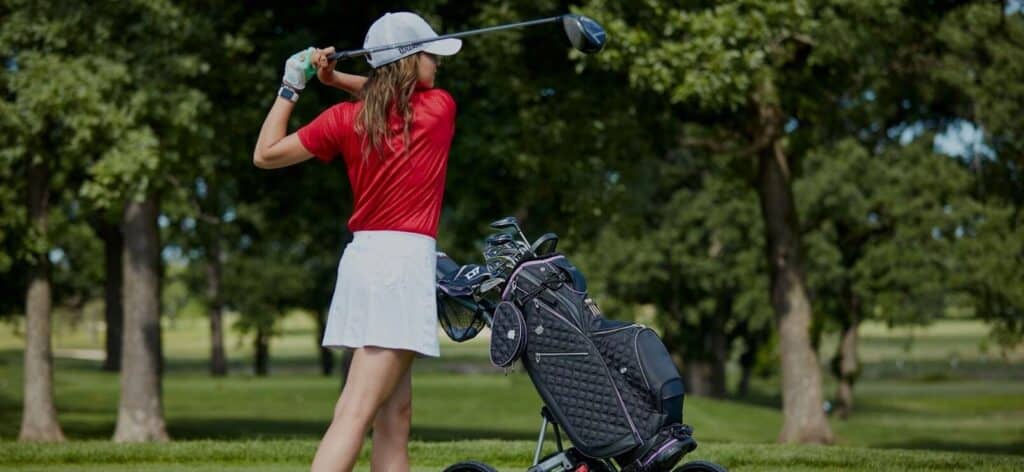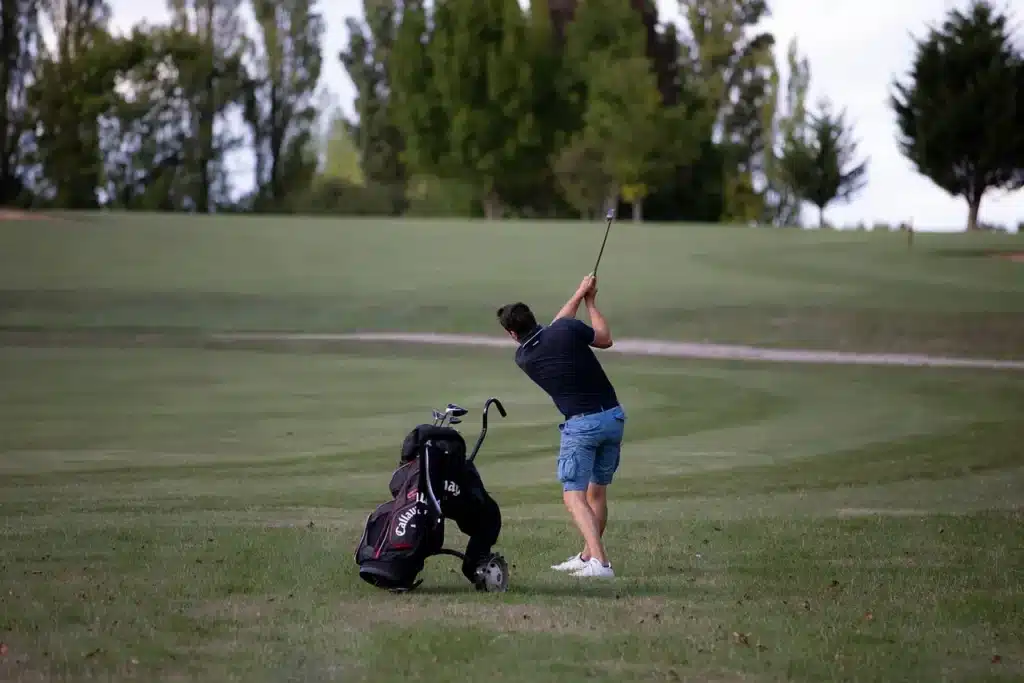Want to send your golf ball soaring to new distances off the tee? How to increase driver distance?
If you’re a devoted golfer looking to improve your game, one part that can make a significant difference is increasing your driver distance. Hitting the ball farther down the fairway not only adds exhilaration to your game but also gives you a competitive edge.
Setting yourself up for short irons and wedges on second shots dramatically increases your chances of making par or better, so striking the ball farther and maintaining accuracy should be the goal of every golfer.
We all need to increase our distance from the driver. And length off the tee is held in such high regard that many amateur golfers kid themselves that they drive the ball 15-30 yards. We have a number of senior golfers at the course where I teach in Florida, and I’m lucky to teach a number of them.
How To Increase Driver Distance? one of my students is an 80-year-old who shoots below his age almost every time he’s on the course. Another is a 90-year-old who still plays regularly, and hits drives over 200 yards when he hits the ball well.
Related Post: How to Increasing Golf Swing Speed
1. Utilizing the Ground for Maximum Efficiency
Having good footwork is very important to help gain distance. The ground is a huge power source for many golfers. At the tour level, you have Justin Thomas, Phil Mickelson, and Lexi Thompson who have really used the ground for power.
Kyle Berkshire, the winner of the Long Drive contest, uses land to generate electricity. You can see how he pushes back to his right, then back to his left and up off the ground to smack the ball.
You can work on this at home by taking a club and making small swings while working back and forth. Feeling the weight from one side to the other. Then lengthen the swing but keep the movement moving sideways. As the swing gets bigger, let your heels come up and feel yourself pushing off the ground on each swing.
2. Upgrade Equipment

As a coach, I try and put together a team that helps my students get better. Dialing in the correct weight, length, material, and design of the clubhead can help swing faster. All of these factors can enhance your game and distance. One effective way to increase your driver distance in golf is to upgrade your equipment.
Newer drivers are often designed with advanced technologies, such as larger clubheads, adjustable weights, and improved aerodynamics, all of which can help you generate more distance off the tee. When you invest in a modern driver that suits your swing and playing style, you’ll have the advantage of added power and precision, allowing you to hit longer, straighter shots.
Additionally, How To Increase Driver Distance? getting custom-fitted for your driver distance can optimize your launch conditions and maximize your potential for increased distance. So, consider upgrading your equipment as a strategic step towards boosting your driver distance and enhancing your overall golf performance.
Your golf equipment plays an important role in achieving greater driver distance. Consider the following aspects:
1. Shaft flex
Choose a driver shaft with the appropriate flex for your swing speed. A shaft that is too stiff or too flexible can limit your distance potential.
2. Loft angle
Choose a driver with a high angle that suits your swing. Correct loft can help you achieve an optimal launch angle for maximum distance.
3. Ball selection
Choose a golf ball that complements your swing and driver. Different balls offer different levels of spin and compression, affecting your ball’s flight and distance.
3. Boosting Backswing Speed for Improved Performance

One of the biggest things unprofessional golfers can do to increase their clubhead speed is to increase their backswing speed. Generally, the greater the flexion of the hips and shoulders. This helps lengthen the swing, giving them more time to gather momentum on the downswing.
We talked about using your levers in the downswing, but using them in the backswing is just as important. Let your wrists tuck first in the backswing. This will make the club feel lighter in the backswing, and create more movement in the clubhead.
A drill I use for this is to hold your club with only your lead hand and try to swing the club halfway. Since you’re only using one arm, your natural reaction will be to try to swing the club first to make it feel light. This is the same feeling you should have in your backswing as you swing your arms back and allow your body to alternate.
Strengthen Core Muscles
- Focus on exercises that target your abdominal and lower back muscles.
- A strong core provides stability and power during your backswing.
Enhance Shoulder Flexibility
- Incorporate shoulder stretches and mobility exercises into your routine.
- Increased shoulder flexibility allows for a fuller, faster backswing.
Practice Rotational Drills
- Engage in drills that emphasize rotational movement, such as medicine ball throws.
- Improved rotation leads to a quicker and more efficient backswing.
Use Speed Training Aids
- Utilize tools like speed sticks or resistance bands to practice faster backswing movements.
- These aids help in building muscle memory for increased speed.
Maintain a Relaxed Grip
- Ensure your grip on the club is firm but not overly tight.
- A relaxed grip promotes fluidity and speed in your backswing.
Focus on Smooth Tempo
- Practice a smooth and controlled tempo during your backswing.
- Avoid jerky movements to maintain speed without sacrificing form.
- Optimize Your Stance
- Adopt a balanced and athletic stance with slightly flexed knees.
- A solid foundation supports a faster, more powerful backswing.
- Improve Lower Body Strength
- Engage in leg and glute exercises to build lower body power.
- Strong legs provide a stable base and contribute to a faster backswing.
- Work on Wrist Hinge
- Practice hinging your wrists properly during the backswing.
- A correct wrist hinge can lead to increased speed and a better angle of attack.
- Regularly Analyze Your Swing
- Use video analysis or work with a coach to review your backswing technique.
- Continuous feedback and adjustments help in refining your speed and performance.
4. Enhancing Training Impact: Intensify Your Practice Swings
When the club moves faster the opportunity for increased distance drivers is enhanced. To do this, simply start making practice swings up rotten the ground. Hold the club head at knee level, swing the club back and complete at that height, and listen for the sound the club makes through the air.
Work to grow the sound as loud as possible without losing your balance. The louder the rustling sound, the greater the clubhead speed and the more possible for increased distance.
· Take a slightly wider stance than normal for a more stable base and to encourage a bit of extra resistance in the backswing.
· Increase driver distance by tipping your right shoulder down at address the right shoulder down a bit more. Place about 60% of your weight on your right side at address
· Increase driver distance by placing the ball forward in your stance on a higher than normal you can position the ball slightly further forward and teed up slightly higher. I wouldn’t encourage this into a headwind, however.
· Increase driver distance by coiling a full shoulder rotation Encourage a big shoulder rotation in the backswing by making sure the left shoulder comes over and across the right knee cap.
· Increase driver distance by keeping resistance in your legs and knees Make sure there is plenty of resistance in the hips and legs. Don’t let the knees activate or spread too much as you turn back.
5. Mastering the Faster Swing
A driver’s designed purpose is to elevate the ball into the air to give you the maximum distance of any shot you take on the course.
Drivers come in varying degrees from 8 degrees up to 10.5 or more. Your swing shape and basics all contribute to your ability to loft the ball with any club, but with different irons where reducing the ball is the name of the game, your driver is intended to be hit upward.
Faster (Not Harder) Swing, this is by a mile the biggest misconception in golf when it comes to swinging and can’t be hammered home enough swing speed is NOT generated by swinging harder! When done correctly, increasing your swing speed is the most real way to add distance to any shot, especially with the driver.
General, How To Increase Driver Distance? your goal is to have your swing be smooth with no wasted motion and use your body and change of weight to create a quick, fluid downswing so that by effect, the ball is getting the full effect of your force. Try working out, becoming more supple, and developing strong swing mechanics overall. Then watch the ball soar!
- Focus on Technique
- Prioritize proper swing mechanics over raw power to ensure control and consistency.
- Work with a golf coach to refine your technique and identify areas for improvement.
- Strength Training
- Incorporate exercises that target your core, legs, and upper body to build the muscles used in your swing.
- Emphasize rotational exercises to enhance your swing speed and power.
- Flexibility and Mobility
- Perform stretching routines to increase your flexibility, particularly in your shoulders, hips, and spine.
- Improve your range of motion to allow for a smoother and faster swing.
- Swing Speed Drills
- Practice with lighter clubs or speed sticks to increase your swing speed.
- Use resistance bands or weighted clubs to build strength and speed gradually.
- Proper Warm-Up
- Engage in a dynamic warm-up before playing to prepare your muscles and joints for a faster swing.
- Include exercises that mimic the golf swing to activate the necessary muscle groups.
- Balanced Stance
- Maintain a stable and balanced stance to support a powerful and controlled swing.
- Distribute your weight evenly and focus on a smooth weight transfer during the swing.
- Consistent Practice
- Dedicate regular practice sessions to working on your swing speed.
- Use a launch monitor to track your progress and make adjustments as needed.
- Mental Focus
- Stay relaxed and focused during your swing to avoid tension that can slow you down.
- Visualize a smooth and fast swing to build confidence and consistency.
- Equipment Optimization
- Use clubs that are suited to your swing speed and style, including the right shaft flex and clubhead design.
- Regularly check and maintain your equipment to ensure optimal performance.
- Monitor Progress
- Keep track of your swing speed improvements and set achievable goals.
- Adjust your training and practice routine based on your progress and feedback.
6. Improve Your Strength and Flexibility

When it comes to increasing your distance with the driver improvements in your golf fitness can rival improvements in technique. If you suffer from poor suppleness for example, you’ll struggle to make a full shoulder turn during the backswing without paying elsewhere like too much hip turn or swaying, both of which effect in a big loss of power and inconsistent ball outstanding.
Increasing your driver distance isn’t just about physical techniques; it’s also about mental and physical conditioning. Here’s how to approach it:
1. Mental Focus
Developmental resilience and focus through mindfulness and visualization techniques. A clear mind can translate into a more precise and powerful swing.
2. Consistent Practice
Consistency is key in golf. Dedicate time to practice your driver shots regularly, incorporating the techniques mentioned above. Repetition is the path to mastery.
7. Leveraging Hand and Wrist Movement with
when your body’s strength declines as you age, it becomes all the more important to use your hands and wrists as your “levers” more effectively. A proper grip that is secure without tension, mostly placed in the fingers, will allow your wrists and arms to move fully through impact.
The feel you’re going for is a “slap” with your trail hand on the ball, where the clubhead will accelerate but not twist causing a bad direction. Flipping your club upside down and making a few swings like this can help increase that feel. A simple adjustment you can make to negate this is to drop your feet back a few inches and point your toes out. These two tricks will help you create more depth in your swing and shorten your swing path.
Understand the Role of Hands and Wrists
- The hands and wrists play a crucial role in generating clubhead speed and controlling the clubface.
- Proper movement and coordination of the hands and wrists can lead to more powerful and accurate shots.
Focus on Wrist Hinge
- Practice a proper wrist hinge during the backswing to create a 90-degree angle between the club and your lead arm.
- This hinge helps store energy that can be unleashed during the downswing, increasing clubhead speed.
Improve Flexibility and Strength
- Incorporate wrist and forearm exercises into your fitness routine to build strength and flexibility.
- Strong and flexible wrists can move more freely and effectively, contributing to better swing mechanics.
Practice Proper Release
- Work on releasing the club at the right moment during the downswing.
- A well-timed release of the wrists can maximize the transfer of energy to the ball, resulting in longer and straighter shots.
Maintain a Light Grip Pressure
- Ensure your grip on the club is firm but relaxed.
- A light grip allows for more fluid wrist movement and prevents tension that can hinder your swing.
Related Post: The Average Golfer Hit a Drive?
Conclusion
The search how to increase driver distance in golf is a journey full of excitement and possibility. By mastering the art of the perfect stance, adopting a solid grip, optimizing your swing, and choosing the right equipment, you’re not just adding yards to your drives, you’re maximizing the true potential of your golf game. unlocking
How To Increase Driver Distance? It’s not just about power; It’s about precision and efficiency. When you go on this journey to increase your driving distance, don’t forget the mental and physical aspects. Strengthen your body, sharpen your mind, and practice consistently. This holistic approach will undoubtedly lead to remarkable results on the fairway.
FAQ: How to Increase Driver Distance
What are the primary factors that influence driver distance?
The main factors include swing speed, launch angle, ball contact, and equipment. Enhancing these aspects can significantly improve your driving distance.
Ware some tips to increase my swing speed?
Focus on strength and conditioning exercises, particularly those targeting your core and rotational muscles. Additionally, practicing proper swing mechanics and using swing speed training aids can help boost your swing speed.
How does the type of driver affect my distance?
The right driver can make a big difference. Look for a driver with a loft and shaft flex that suits your swing style. Modern drivers are designed with technology that can help increase distance, such as adjustable weights and aerodynamics.
Why is the angle of attack important for driving distance?
A positive angle of attack, where you hit the ball on the upswing, can help increase your launch angle and decrease spin, both of which contribute to longer drives.
Are there any specific drills to help improve driving distance?
Yes, drills like the “tee drill,” where you focus on hitting the ball higher on the clubface, and “swing speed drills,” which involve practicing with lighter clubs or speed sticks, can be very effective.







